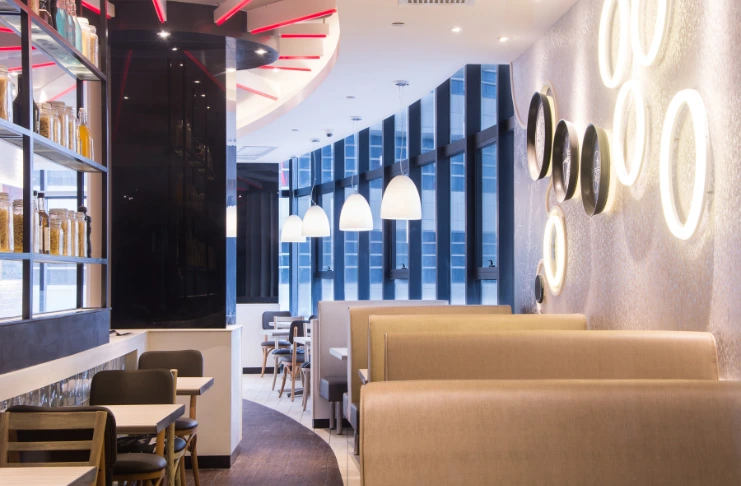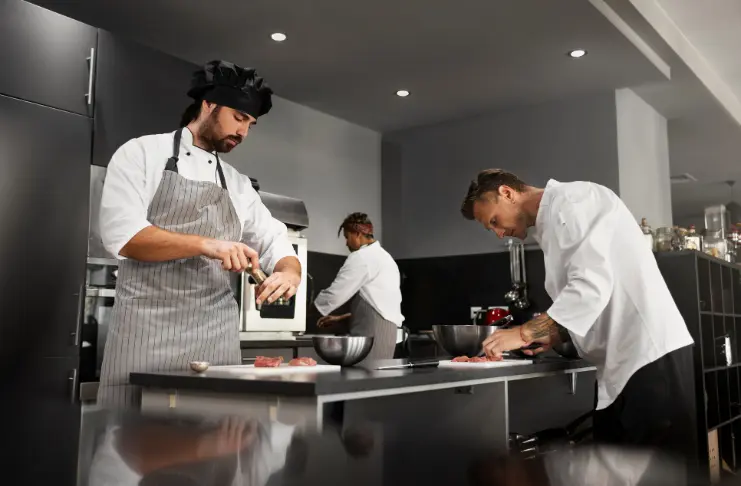In a sea of dining options where foodies navigate by Instagram posts and five-star reviews, what invisible ingredients separate the buzz-worthy hotspots from the forgotten? The restaurant industry’s competitive landscape shows no mercy – yet some establishments don’t just survive, they thrive, becoming neighborhood institutions or destination dining experiences.
Behind every successful restaurant, restaurant owners know that there lies a carefully crafted blend of elements that work in harmony. While a talented chef or a prime location might seem like the obvious success factors, the reality is far more nuanced and fascinating.
The magic happens when all these elements align—when the food, atmosphere, service, and purpose work in concert to create something greater than the sum of their parts. In this perfect harmony lies the secret to restaurant success that no business plan alone can capture.
If you are also wondering what makes a successful restaurant business, this comprehensive guide explores exactly that. Keep reading to find out!
Key Features of a Successful Restaurant
If you’re searching for what makes a restaurant successful, your search ends here. This comprehensive guide covers everything from A to Z, providing insights, strategies, and industry best practices to help you build and sustain a thriving restaurant. From food quality to customer experience, here are the key features that define a restaurant’s success:
INDUSTRY INSIGHTS
| Understanding what drives restaurant success requires a look at industry statistics and expert opinions. According to the National Restaurant Association, the U.S. restaurant industry is projected to generate $1.2 trillion in sales by 2030, reflecting its steady growth. However, research suggests that nearly 60% of new restaurants fail within the first year, and 80% shut down within five years due to poor management, lack of differentiation, or financial struggles. |
These statistics highlight what makes a restaurant successful by pointing out the importance of quality food, excellent service, strategic branding, and strong financial management in ensuring long-term success.
1. A Strong and Unique Concept

A successful restaurant begins with a compelling concept. Whether it’s fine dining, fast-casual, or a niche cuisine, your concept should be clear, unique, and aligned with your target audience’s expectations. Key elements are:
- A restaurant’s concept should be distinct, memorable, and market-aligned.
- The theme must reflect branding, decor, menu, and customer experience.
- A unique selling point differentiates restaurants from competitors and attracts customers.
Implementation:
A great concept is more than just a type of food—it’s an experience. Every aspect should reinforce your concept, from the decor and menu to the restaurant staff’s uniforms and service style.
Research your competition and customer preferences to create a distinctive identity. Maintain consistency in branding across all platforms, including physical and digital spaces, to strengthen recognition and appeal.
2. Exceptional Food Quality and Consistency

No restaurant can survive without good, high-quality food. Consistency is key—customers should receive the same excellent taste and presentation with every visit. Ways to ensure quality are:
- High-quality ingredients ensure consistently flavorful, fresh, and well-prepared dishes.
- Standardized recipes maintain consistency across multiple chefs and restaurant locations.
- Regular quality control prevents deviations in taste, presentation, and portion sizes.
Implementation:
Create standardized recipes and cooking procedures to maintain uniformity. Implement rigorous quality control measures, including regular ingredient sourcing reviews and kitchen inspections. Train your kitchen staff to follow precise cooking techniques, ensuring every dish meets customer expectations.
3. Outstanding Customer Service

Service can make or break a restaurant experience. Friendly, attentive, and efficient service creates a welcoming atmosphere that keeps customers coming back. Key aspects include:
- Friendly and knowledgeable staff create a welcoming dining atmosphere.
- Addressing customer concerns promptly enhances satisfaction and brand reputation.
- Personalized service makes diners feel valued and encourages repeat visits.
Implementation:
Develop a comprehensive training program focused on communication, problem-solving, and hospitality. Encourage a customer-first mindset by recognizing and rewarding employees who go above and beyond. Use customer feedback to identify areas for improvement and implement strategies to enhance service quality.
4. Strategic Location and Accessibility

A restaurant’s location plays a significant role in its success. A great location ensures visibility and easy accessibility for customers. Consider these factors:
- Choosing a high-traffic area increases restaurant visibility and customer flow.
- Easy access, parking, and transportation options improve customer convenience.
- Proximity to target audiences ensures consistent patronage and business sustainability.
Implementation:
Conduct thorough market research to identify high-demand areas. Work with real estate professionals to secure prime locations. Enhance accessibility with clear signage, well-lit entrances, and user-friendly online maps for easy navigation.
5. Effective Marketing and Branding

A strong brand and marketing strategy help restaurants attract new customers and retain existing ones. Digital presence is crucial in today’s competitive landscape. Some effective marketing strategies are:
- Strong branding differentiates a restaurant and builds customer loyalty.
- Social media promotions attract new customers and increase online engagement.
- Customer testimonials and reviews establish credibility and improve the restaurant’s reputation.
Implementation:
Develop a strong social media presence by posting engaging content, including food and beverage items, behind-the-scenes footage, special offers, and customer testimonials. Leverage digital ads, email marketing, and SEO strategies to increase visibility. Encourage user-generated content through hashtag campaigns and contests.
6. A Welcoming Ambiance and Interior Design

A restaurant’s ambiance significantly influences customer experience. The design, lighting, and music should complement the overall theme. Important aspects are:
- Comfortable seating enhances dining experiences and prolongs customer visits.
- Proper lighting and decor set the restaurant’s mood and vibe.
- Background music should complement the theme without being too loud.
Implementation:
Invest in ergonomic furniture, mood lighting, and acoustic planning. Work with professional designers to create a space that reflects your restaurant’s identity. Regularly update the decor to maintain freshness and appeal.
7. Efficient Kitchen and Workflow Management

A well-organized kitchen and streamlined workflow ensure smooth operations and timely service. Some Key Aspects are:
- An organized kitchen layout reduces preparation time and improves efficiency.
- Clear communication among staff ensures smooth operations during peak hours.
- Implementing inventory systems prevents food waste and controls ingredient usage.
Implementation:
Train kitchen staff to work in a coordinated manner and use technology for better order management and inventory control.
8. Competitive and Fair Pricing

Pricing plays a crucial role in attracting and retaining customers while maintaining profitability. Key aspects are:
- Menu pricing should reflect food costs, quality, and market competition.
- Offering value-driven promotions attracts customers without compromising profitability.
- Regular pricing analysis ensures alignment with consumer demand and expectations.
Implementation:
Optimize kitchen space with a well-planned layout to ensure seamless operations. Implement a clear workflow for food preparation and service to reduce delays. Use technology like kitchen display systems (KDS) and inventory management software to streamline processes and minimize waste.
9. Strong Financial Management

A restaurant’s financial health determines its long-term viability. Key aspects include:
- Tracking daily expenses helps maintain restaurant profitability and sustainability.
- Budgeting prevents overspending and improves financial resource allocation.
- Profit margin analysis ensures that menu pricing aligns with business goals.
Implementation:
Maintain a detailed budget and track daily financial transactions to prevent overspending. Use accounting software to monitor cash flow, expenses, and profitability trends. Schedule financial audits and adjust pricing strategies based on performance analysis.
10. Leveraging Technology and Digital Tools

Integrating technology improves efficiency and enhances customer experience. Important aspects involve:
- Online ordering systems enhance customer convenience and boost sales.
- POS software streamlines transactions and reduces billing errors.
- Digital marketing tools improve engagement and attract potential customers efficiently.
Implementation:
According to a study, 80% of diners say they prefer a restaurant experience with technology integrated within it. Adopt digital solutions like POS systems for efficient order management and payment processing. Integrate online ordering and delivery platforms to expand reach. Utilize data analytics to understand customer preferences and optimize menu offerings. Implement mobile-friendly websites and apps for seamless customer interaction.
Leverage AI-driven chatbots to handle customer inquiries and reservations efficiently. Utilize automated inventory tracking systems to minimize waste and ensure real-time stock updates. Cloud-based restaurant management software can streamline operations and improve decision-making. Investing in smart kitchen technology can reduce energy consumption and enhance workflow efficiency.
Digital loyalty programs encourage repeat customers and improve brand engagement. Social media integration with booking platforms can enhance customer experience and increase reservations.
11. Sustainable and Ethical Practices

Eco-friendly and socially responsible food service businesses attract a growing base of conscious consumers. Key aspects include:
- Sourcing local ingredients supports communities and reduces environmental impact.
- Implementing zero-waste policies minimizes food waste and operational costs.
- Ethical labor practices ensure staff well-being and business credibility.
Implementation:
Source ingredients from local, sustainable farms to reduce carbon footprint. Implement eco-friendly policies, such as composting food waste and using biodegradable packaging. Ensure ethical labor practices by providing fair wages and a healthy work environment.
12. Strong Online Presence and Reputation Management

Online reviews and digital visibility impact customer perception and foot traffic. Important aspects of a strong online presence include:
- Regularly updating social media keeps customers engaged and informed.
- Responding to online reviews enhances trust and improves restaurant perception.
- SEO-optimized websites increase visibility and attract potential customers online.
Implementation:
Engage actively on social media by responding to reviews and sharing updates. Monitor online reputation through review platforms and address negative feedback professionally. Optimize your website for SEO to improve visibility and attract organic traffic.
13. Adaptability and Innovation

Successful restaurants stay ahead by embracing new trends and customer preferences. Some Key aspects are:
- Updating menus introduces new flavors and keeps customers interested.
- Adapting to market trends ensures relevance and long-term success.
- Experimenting with unique dining experiences differentiates the restaurant competitively.
Implementation:
Regularly update the menu with new, trendy dishes while maintaining customer favorites. Monitor industry trends and customer feedback to stay ahead of the competition. Experiment with pop-up events or limited-time offers to test new concepts and drive excitement.
14. Community Engagement and Customer Loyalty Programs

Building a loyal customer base ensures repeat business and positive word-of-mouth. Note the following aspects of community engagement:
- Hosting community events strengthens brand presence and builds customer connections.
- Offering loyalty programs encourages repeat visits and customer retention.
- Supporting local causes enhances goodwill and attracts socially conscious diners.
Implementation:
Launch a loyalty rewards program that offers discounts or free items after a certain number of visits. Host community events or partner with local businesses to build relationships. Show appreciation to loyal customers with personalized promotions or exclusive events.
Conclusion
A successful restaurant is more than just great food—it’s a combination of multiple factors, from excellent service and strategic branding to operational efficiency and strong financial management. By focusing on these key restaurant features, you can create an establishment that not only attracts customers but also retains them for the long haul. Consistency is key, as customers return to restaurants that offer reliable quality and a memorable experience.
Moreover, adaptability plays a significant role in long-term success. The restaurant industry is constantly evolving, with new trends, customer preferences, and technological advancements shaping the market. Staying ahead by embracing innovation, sustainable practices, and customer feedback ensures continuous growth.
Building a loyal customer base also requires emotional connections. Engaging with the local community, offering personalized service, and creating a welcoming ambiance help foster lasting relationships. Marketing strategies, both online and offline, contribute to visibility and reputation management.
With careful planning, passion, and a commitment to quality, your restaurant can achieve long-term success and industry recognition.
Frequently Asked Questions
1. What determines the success of a restaurant?
A restaurant’s success depends on factors like high-quality food, excellent service, strong branding, strategic location, and effective financial management. Consistently delivering a great dining experience builds long-term customer loyalty.
2. What are the three core elements of a successful restaurant?
The three core elements are food quality, customer service, and ambiance. A well-balanced combination of these ensures a memorable experience that encourages repeat visits.
3. What is the restaurant’s key to success?
The key to success is consistency in delivering great food, maintaining excellent service, and adapting to customer preferences while managing operations efficiently.
4. How do you attract customers to your restaurant?
Leverage social media, offer promotions, provide a unique dining experience, ensure excellent customer service, and encourage word-of-mouth marketing through satisfied customers.
5. What types of restaurants are the most successful?
Fast-casual, specialty-cuisine, and experience-driven restaurants (like themed or farm-to-table concepts) perform well due to customer demand for quality, convenience, and uniqueness.
6. What does it take for a restaurant to be successful?
Success requires a strong concept, a well-trained team, financial stability, effective marketing, and the ability to adapt to trends and customer feedback.
7. What are the three Cs in a restaurant?
The three Cs are Cuisine, Customer service, and Cleanliness. These elements ensure customer satisfaction and a strong reputation.
8. Do successful restaurants make a lot of money?
Yes, successful restaurants can be highly profitable, but profitability depends on factors like location, pricing strategy, cost control, and customer retention.
9. What are the features of a themed restaurant?
Themed restaurants have unique decor, immersive atmospheres, menus aligned with the theme, and staff trained to enhance the experience.
10. What are the features of a specialty restaurant?
Specialty restaurants focus on a specific cuisine or dish and offer high-quality ingredients, expert chefs, and a distinctive dining experience.
11. What are the features of fast food restaurants?
Fast food restaurants emphasize quick service, standardized menus, affordability, and convenience through drive-thrus, takeout, and delivery options.
12. How do you describe a good restaurant?
A good restaurant provides delicious food, excellent service, a welcoming ambiance, fair pricing, and a seamless dining experience.
13. How can I make my restaurant unique?
Offer a distinctive menu, create a memorable ambiance, incorporate storytelling into your brand, provide exceptional customer service, and engage with your community.





